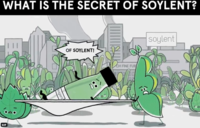Thursday, October 3, 2019
Soylent's Brilliant New Marketing Campaign: Soylent Is Plants, Not People

For years, Los Angeles-based Soylent (www.soylent.com)--which makes all-in-one meal replacement drinks, bars, and other products—danced around the origins of the name, which is tied to a dystopian 1973 science fiction film, Soylent Green, featuring Charlton Heston. Last week, the company finally embraced the dystopian origins of the name with a brilliant, tongue-in-cheek marketing campaign introducing its new Soylent Green Mint Chocolate line—complete with a spoof animation of the famous last scene of the Heston Soylent Green film. In the film, the main character is horrified to find that the artificial food is secretly made from people—in their spoof, the “secret of Soylent” is it's made of plants. We caught up with Soylent VP of Marketing, Andrew Thomas, to hear how the company finally decided to embrace the name—and the frequent trolling on social media—to instead emphasize the sustainable aspects of its products, as well as the new product line, with “Plants, Not People”.
How did you decide to finally embrace the interesting origins of your name?

Andrew Thomas: It really started with the selection of the flavor for our latest line extension, Mint Chocolate. In our consumer research, the top flavor request has been for mint chocolate, which has been at the top or near the top of the requests, depending on what you were looking at in the data. We ended up developing that for our launch in September. As we started to look at labeling and packaging design, and to differentiate the product, we thought it would fun to finally do a green label. We thought it was time to lean in on the Soylent Green jokes and comments that we always get. So, it was really born of the flavor selection, which greased the skids for the campaign.
There's a great animated video which references the classic Soylent Green movie ending, how did that come about?
Andrew Thomas: It all actually tied together with the origin of the name of the brand, as well as our sustainability mission. Most people know about the movie, but the movie was actually based on a book, titled Make Room, Make Room, by Harry Harrison. The founders had actually based the company and brand on Soylent from the book, not the movie, because they wanted to design a product that was more sustainable, because they were concerned about overpopulation, with 9.7 billion people by 2050, and figuring out how we are going to feed everyone. It's sustainable and green in that way, in that we're good for the planet. It's part of our DNA. As we looked at developing the new line, we figured that not only will the label be green, it would be the perfect opportunity to tie in the sustainability messaging with our product launch, which is why you'll see “Plants Not People”, because Soylent is plant-based. That's why we showed the people in the scene as plants and we changed the line to “you've got to tell them Soylent is made of plants!” It just really hit it on the nose that we're plant-based, but also works so well as a reference to the movie. We get so many jokes and comments on social media about that, and we thought it was time to lean into that a bit.
When you first joined in marketing, did you think that maybe it might have been a mistake for the company to have picked Soylent as the name of the company in the first place?
Andrew Thomas: I've been here for nearly a year and a half now, and it was one of those things I knew what I was getting into. I liked that the company chose that name, because it's disruptive. The brand has always had a rebellious nature behind it, not just with the name itself, but also with what we did a year ago putting up a billboard saying how we're pro-GMO. In a city like Los Angeles, that's not a very popular opinion. We stood up for it, because we're unapologetic about our stance in being pro-science and about everything our our Soylent products. For me, it was a great, disruptive name, because it's something people are going to talk about, because there's some inherent buzz around it. That said, it does come with a challenge. We get lots of comments about our name on social media. And, “don't feed the trolls” has typically been our policy for that. Even with the name, people don't necessarily know what the product is. So, we knew we had some work there, so we've spent the entire year focused on marketing communications and educating consumers on what's in the bottle, and why it's good for them and the planet.
I know your first customers used to be the techies and coders, what does your user base look like now?
Andrew Thomas: It's traditionally been the techies, the tech entrepreneurs, coders, gamers, and college students. We still consider that our core consumer, because the need they have is still very real. There are lots of reasons to use Soylent products during their day. What we've done now, is said—that's the kernel and nugget, and what insight does that give us that is applicable to other people? What we've realized, is those core consumers are what we are calling hustlers. They are people who might have a job that consumes all of their waking hours. They might have two jobs, a main job and a side gig. The reality is, there are lots of people, from the techies, the gamers, students, nurses, construction workers, rideshare drivers, teachers, dance instructors, and a whole host of other people on their grind, who just don't have the time to prepare their own food and to track down a healthy meal on the go. That's where Soylent comes in. We talk about these moments where there is a “food void”, that moment where someone is unable to afford or access or find sustainable, healthy nutrition, which a body needs to thrive. If you extend concentric circles from that core, there are people who, in a lot of ways, behave like our core, but where it helps us to be more broadly appealing, more mass consumer than we've done in the past, and we are trying to show them we're good for you, good for the planet, and convenient for you when you need it.
So where is the company selling its products now?
Andrew Thomas: As you know, we started as a direct-to-consumer brand on Soylent.com. That helped us build an online, subscription model, which we started about five years ago. Lots of brand start with a lot of light users and hope to those users might become medium or heavy users. We're unique, in that we started with the heavy users. Those users would buy two, three, or four cases a year, and sometimes they'd buy that much in a month. We really got off to a great start in the space with heavy users on our dot com size, and also on Amazon, where the minimum buy was a case. As we are continuing to grow, we have started to attract more of a mass audience, of people who don't necessarily want to commit to buy 12 bottles at a time at $39.00 for a case, or a little lower depending on the deal. That's where our retail strategy comes in. Our retail footprint now has 17,000 stores, including 7-Eleven, Target, and Kroger. That's been a great way to drive trials with people, with a lower cost of entry. The commitment there is now just one bottle, at $3.49 to $3.99 a bottle. It's also been a great way to advertise, to be on those shelves, and not just rely on online ads. That allows us in marcom to open up on some of the activities we'd like to do. Traditionally, we'd been very focused on performance marketing, and things that work in the online world. Now, we're putting a lot of effort into the real world, with out-of-home radio and TV. It's been an exciting time to do marketing as we try to expand to other channels and to build our consumer base.
So what's the big push now at Soylent?
Andrew Thomas: This year, we launched a few new products. We launched Soylent Bridge, a lower calorie alternative to our core Soylent. That was something our customer base has been asking for now. It also was a great way to bring in new customers to the franchise. Obviously, we just launched Mint Chocolate. We also launch Soylent Squared, the 100 calorie mini meal bar, which we launched in April. The reason we launched Squared, it is a more familiar format for people looking for a meal replacement. There are lots of people who use protein bars as a meal replacement, and it was a good introduction of them to our franchise, where they're not necessarily looking for a drink with 400 calories in a bottle. That additional format play helped to drive additional awareness and trials. We will continue to look forward at other formats that make sense and fall in line with our brand ethos. We also will continue to innovate on our drink line, because there are lots of players out there in the functional beverage area. We'll be adding beverages and drinks that consumers will see benefits in, and we'll be launching new products in 2020 with even more benefits and options for new consumers.
Thanks for sitting down with us and opening up on the whole name issue!
Andrew Thomas: It's been a fun opportunity. We've gotten so many comments over the years, and finally having our marketing team have a tongue-and-cheek way to respond to those comments has allowed our entire team to have lots of fun with it. One other thing, which I need to mention, is in conjunction with the launch, we've also completed a lifecycle analysis of Soylent. That study analyzed everything it takes to create our product—from sourcing, to farming, to production, to when it's all delivered to consumers, and the point of that lifecycle analysis is to compare Soylent to other products, meals, and foods people eat. That lifecycle analysis and the launch of Plants Not people really works in conjunction to further establish our sustainability credentials. Green isn't just about the mint, it's not only about the reference to the film, but it's also something we're proud about from the sustainability angle.
Thanks!